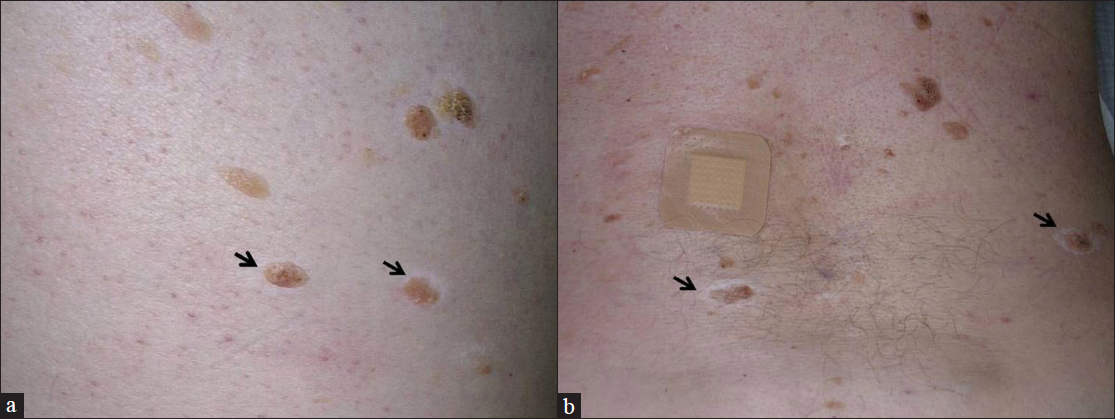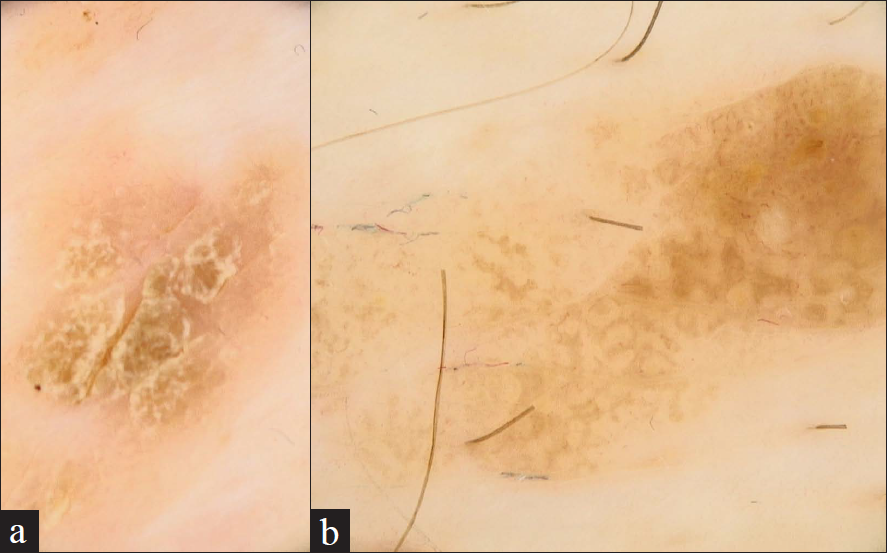Translate this page into:
Halo phenomenon is not restricted to melanocytic lesions
Corresponding author: Dr. Ayşe Tunçer Vural, Department of Dermatology, Başkent University Faculty of Medicine, Ankara, Turkey. ayse.tunce@gmail.com
-
Received: ,
Accepted: ,
How to cite this article: Tunçer Vural A, Güleç AT. Halo phenomenon is not restricted to melanocytic lesions. Indian J Dermatol Venereol Leprol 2022;88:656-7.
Sir,
The halo phenomenon is characterized by the destruction of melanocytes around a skin lesion leading to a peripheral hypo- or depigmented halo. The most common form of the halo phenomenon is the halo nevus in which the halo is observed around a melanocytic nevus.1 Nevertheless, there are a few cases of non-melanocytic lesions such as angioma, basal cell carcinoma and neurofibroma presenting with halo phenomenon in the literature.2,3 Only a few reports published so far have documented halo phenomenon in seborrhoeic keratosis.4,5
A 71-year-old man presented with a 20-year history of numerous scaly brownish skin lesions on his body. His medical history was unremarkable. Dermatologic examination revealed multiple well-defined, yellowish-brown, hyperkeratotic plaques of 5-20 mm diameter on his trunk. Five of these lesions were encircled by a depigmented halo [Figures 1a and b]. Dermoscopic examination of the sharply demarcated brown lesions by a computerized polarized light videodermatoscope (FotoFinder Dermoscope; TeachScreen Software GmbH, Bad Birnbach, Germany) disclosed comedo-like openings, milia-like cysts and/or brain-like appearance, while depigmented areas encircling these five lesions were observed as white structureless areas [Figures 2a and b]. The patient was diagnosed with seborrheic keratosis with halo phenomenon. He was not aware of the white rings surrounding the lesions and denied any history of trauma or sunburn. The patient was asked to follow up in 3 months but was lost to follow-up.

- Numerous seborrheic keratosis encircled with white halos (arrows) located on the abdomen (a) and the back (b)

- White structureless areas surrounding seborrheic keratosis that display comedo-like openings, milia-like cysts, or brain-like appearance on dermoscopy (original magnifications: a-b ×20)
Halo nevus was first described by Hebra in 1874. However, its etiopathogenesis is not well understood. It is believed to result from an auto-immune response against melanocytes. Sunburn or local skin trauma are suggested triggers that could lead to initiation of self-reactivity, albeit most cases are idiopathic. In its typical course, the melanocytic lesion located in the centre fades away in time, eventually disappearing completely.
In 1983, Migally et al. published the first case of seborrheic keratosis with halo phenomenon. The patient had both vitiligo and seborrheic keratosis, and some of the seborrheic keratosis on his back were encircled with white halos.4 A second case with similar findings was reported in 1993. Interestingly, that 69-year-old man had been simultaneously diagnosed with colon carcinoma, and the whitish halos around seborrheic keratosis had disappeared after colon surgery. It was hypothesized by the authors that appearance of white halos could have been provoked by an immune mechanism initiated by his colon cancer.5 In the present case no definite predisposing factors like sunburn or skin trauma or concomitant disease could be identified.
The halo phenomenon can rarely be seen around seborrheic keratoses, and may arise without an associated autoimmune disease or an underlying malignancy.
Declaration of patient consent
The authors certify that they have obtained all appropriate patient consent.
Financial support and sponsorship
Nil.
Conflicts of interest
There are no conflicts of interest.
References
- Phenomena in dermatology. Indian J Dermatol Venereol Leprol. 2011;77:264-75.
- [CrossRef] [PubMed] [Google Scholar]
- Basal cell carcinoma with halo phenomenon in a young female: Significance of dermatoscopy in early diagnosis. Indian J Dermatol. 2015;60:214.
- [CrossRef] [PubMed] [Google Scholar]
- Clinical characteristics of the halo phenomenon in infants with neurofibromatosis 1: A case series. Acta Derm Venereol. 2018;98:153-4.
- [CrossRef] [PubMed] [Google Scholar]
- Halo seborrheic keratosis associated with colon carcinoma. Int J Dermatol. 1993;32:846.
- [CrossRef] [PubMed] [Google Scholar]





